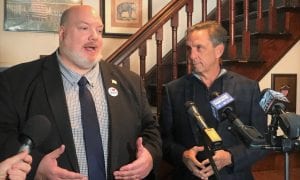WESTFIELD – The City Council voted unanimously last night to approve a $10 million bond order, just a week after it appeared to be a dead issue.
Bond orders need a super majority, which in the case of the City Council is nine affirmative votes, to win approval. Last week, the council had just nine members at a special meeting called by Council President Brian Sullivan.
The $10 million bond is being requested by Mayor Daniel M. Knapik for Phase 1-B of the Energy Management System (EMS) program that includes work at City Hall, Westfield High School and Westfield Vocational Technical High School that was not included in the $17 million EMS Phase 1-A.
Energy improvements were made at the two school buildings, resulting in substantial reductions in energy consumption, but further controls, sensors and ventilation systems need to be installed to maximize the benefits of the new hot water heating that replaced the boilers originally installed in those buildings 40 years ago.
The City Hall work will encompass installation of a hot water heating system, new lights, revamping the electrical system, air conditioning, American with Disabilities (ADA) compliance, parking lot expansion and repaving and environmental remediation for asbestos.
The bond order was defeated on April 11 at that special meeting when At-large Councilor David A. Flaherty said that the projections for revenue and expenses over the next five years, the second set of numbers provided by the administration’s financial team, were better than the initial calculations, but still not sufficiently accurate to win his vote.
“But the numbers are still wrong,” Flaherty said. “The projections for revenue and expenses are better, but I don’t think they are accurate enough for me to vote for this.”
Flaherty said the numbers on investment earnings are still too “rosy” and that no “plan of attack for OPEB (other post employment benefits)” was submitted as part of the financial report. “There is not even an attempt to pay anything into that.”
“So I am going to vote ‘no”,” Flaherty said.
Flaherty did vote no, and Ward 3 Councilor Ann Callahan was also coached, by former Ward 3 Councilor and now Community Development Director Peter J. Miller Jr., to vote against the bond in order to request a minority reconsideration of the vote at the regular meeting conducted last night.
And for the second session in two weeks, there were only nine councilors present to vote on the bond. Several councilors were absent because of family vacations scheduled for the April school vacation week.
The composition of the councilors present last night was slightly different than last week, with Ward 4 Councilor Mary O’Connell and At-large Councilor Agma Sweeney in attendance at this session. O’Connell was not present last week and Sweeney was also absent.
At-large Councilors James R. Adams and Flaherty were not present last night. Adams had voted in support of the bond, while Flaherty had forced the reconsideration vote by voting no on the bond.
Ward 5 Councilor Richard E. Onofrey Jr., who initially supported Flaherty’s request for revised revenue projects, also argued that the city needs to maintain an annual debt of between $6 and $7 million. The annual debt is currently about $5.5 million and if it is not increased, that debt capacity will be diverted into the city’s operating budget.
“If that happens, we’ll never be able to get it back, it will be gone and we’ll never be able to bond for projects in the future,” Onofrey argued last night. “We have the (revenue and expense projection) numbers. We can afford this. We have to preserve that bonding capacity in order to do these projects for the school and City hall.
“We can’t take out the new windows (of City Hall) and put the air conditioners back in every office,” Onofrey said.
Sullivan called for a roll call vote on the first reading of the bond under the reconsideration process, an unusual step since those are typically voice votes, perhaps to gauge the support of the councilors present. That vote was 9-0.
Then Sullivan called for a motion for the final vote, which could have been defeated had any councilors changed to a “no” vote, but the bond order was again approved by a 9-0 vote.







